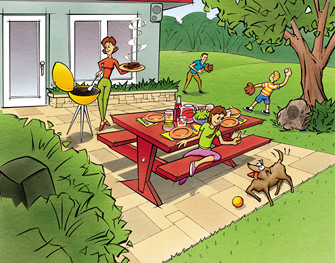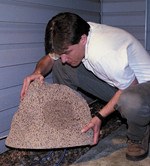Backyard Bonanza
My, how times have changed. Back when vinyl records were king and a 25-inch-diagonal TV screen was considered big, here's how you had a good time in the backyard: a keg of beer, burgers on a charcoal grill, and your roommate's big, ugly speakers (carted out from the living room) blasting Rush (Geddy Lee, et al) until the conservative neighbors call the cops. A decade or so goes by, and the fun gets more sophisticated: a cooler of imported beer (maybe a margarita machine), steaks on a gas grill, and a big, ugly boombox belting out Rush (Limbaugh) until the liberal neighbors call the cops. Today, it's likely to be takeout from a local BBQ joint, a mini-fridge full of hard lemonade, and steam from the hot tub mingling with big-band music from outdoor speakers hidden somewhere in the (twice-monthly manicured) foliage.

Maybe you're too young to have witnessed the aging of the baby boomers firsthand; however, if you've ever owned a home, rented one, or just visited a friend's, there were certainly times when you wished you had speakers outside—or caught yourself coveting the speakers someone else had. The previous owners of my house—the kind of people who've helped make Wal-Mart the retailing behemoth it is today—even caught the bug. They installed a swanky set of Universal (that just sounds high-end, doesn't it?) three-way outdoor speakers (with 3-inch woofers!) around the patio. Of course, I can't find proof that they ever actually ran speaker wire to them, which is a good thing because these speakers make ice crushing in a blender sound absolutely symphonic by comparison. So, the way I see it, I can either sell the house or get new speakers. I think you're with me on this one.
The Trials and Tribulations of an Outdoor Speaker
Finding the right outdoor speaker is a little different from selecting a good inside-the-home speaker. There are a couple of unique issues you need to be aware of before you start shopping. First, although you may end up placing them in a garden setting, life won't be a bed of roses for these speakers. While your home theater's speakers have it easy in a nice, climate-controlled environment, the outdoor ones must suffer through rain, shine, sleet, snow, hurricanes, and hailstorms. Each day, the sun will work at tearing down the molecular bonds of the speakers' cabinets and drivers.
 You should look for speakers that are constructed of weather-resistant materials like coated aluminum, stainless steel, and polypropylene. Some outdoor speakers are ported to improve efficiency, which is a major benefit outside, but the opening can pose a problem. Make sure any ports are covered so that music-loving birds and wasps don't build nests in them. You'll also need to give some thought to the mounting location and orientation. Unless you want to use the speaker as a rain gauge, don't point the port upward or mount it where it will receive a direct stream of water from runoff during a downpour or your weekly lawn watering.
You should look for speakers that are constructed of weather-resistant materials like coated aluminum, stainless steel, and polypropylene. Some outdoor speakers are ported to improve efficiency, which is a major benefit outside, but the opening can pose a problem. Make sure any ports are covered so that music-loving birds and wasps don't build nests in them. You'll also need to give some thought to the mounting location and orientation. Unless you want to use the speaker as a rain gauge, don't point the port upward or mount it where it will receive a direct stream of water from runoff during a downpour or your weekly lawn watering.
The second thing that makes life difficult for an outdoor speaker is the lack of boundaries. A speaker that has plenty of volume and bass indoors can often sound weak and anemic outdoors. That's because there's normally only one (often, not even that) wall near an outdoor speaker. In essence, the speaker attempts to fill the space that extends from your backyard to the edge of the atmosphere. Add the high level of natural ambient noise from crickets and other bugs, traffic, lawn mowers, barking dogs, and, well, you get the idea. What's important is to be realistic. Although an outdoor speaker system can sound pretty darn good, it's unlikely that you'll ever achieve one of those orgasmically epiphanic musical experiences that a tweaked, high-end arrangement inside your home can give you. (You'll certainly have some sort of experience after a six-pack of hard lemonade in a hot tub, but that's beyond the scope of this article.) With outdoor speakers, imaging and depth play a much less important role than tonal balance, efficiency, and dispersion.
Installation Advice
Before you walk into your local A/V retailer, you need to do a little homework. First, survey the area you want to cover with sound. Most manufacturers recommend one pair of speakers to cover between 200 and 400 square feet. For larger areas, use more speakers, alternating the left and right channels throughout. This ensures that, as you and your guests walk around, you'll always be between a left and a right speaker. Some companies are introducing single-cabinet speakers with stereo inputs and dual tweeters to help cover these areas.
 You should also take into consideration how much amplifier power you have. Larger areas, more speakers, and louder volumes will come with increased power demands. Many installers recommend a separate amplifier to power the outdoor speakers; this is wise, since too much power is rarely a problem. You're more likely to damage your speakers by asking a small amplifier to give more power than it's got, resulting in distortion and blown drivers.
You should also take into consideration how much amplifier power you have. Larger areas, more speakers, and louder volumes will come with increased power demands. Many installers recommend a separate amplifier to power the outdoor speakers; this is wise, since too much power is rarely a problem. You're more likely to damage your speakers by asking a small amplifier to give more power than it's got, resulting in distortion and blown drivers.
Take note of your surroundings. If you have close neighbors (geographically, not socially), you should probably install the speakers at the far end of the coverage area and point them back toward your house. This helps diminish the amount of sound drifting into adjacent yards. Having your house as a boundary opposite the speakers will also reinforce the sound in the listening area, making the speakers' and amplifier's difficult job that much easier.
You need to decide what type of listening you'll be doing. Do you want to get as much imaging and detail as possible, or will you be using the speakers for background music and sports broadcasts? For the best imaging, mount the speakers (higher is usually better) in a direct line to the main listening area. If ambience is what you're aiming for, hide the speakers behind bushes or in trees; they'll sound fine and look good, too.























































